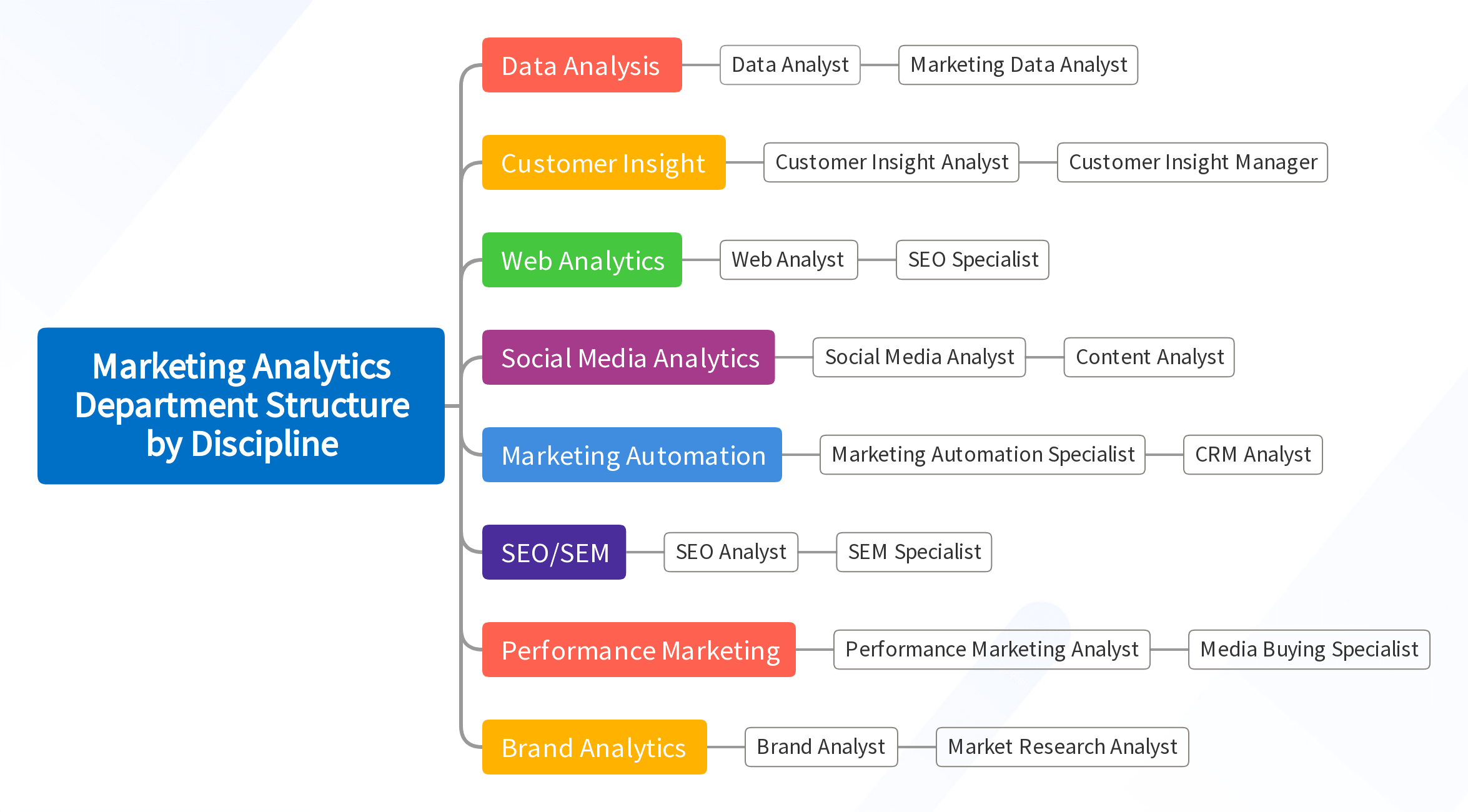

Structuring a marketing analytics team is a crucial task. It shapes the success of businesses in our fast-paced world.
These teams transform raw data into valuable insights. Their work drives strategic decisions and fuels growth. We've learned this firsthand while growing our own marketing agency, GrantSpark.
But first, let's talk about the Marketing Analytics department structures you have to choose from.
Best for Growth Marketers
Best for Paid Ads & CMO's
Table of Contents
Structuring Marketing Analytics Department
There are two main types of department structures based on company size and resources.
- Marketing Analytics department structure by discipline
- Org Type: Traditional corporate departments
- Best For: Midsize/Enterprise companies
- Marketing Analytics department structure by function
- Org Type: Employees are grouped by activities and objectives
- Best For: Small to Medium Sized Business (SMB)
Let’s go in-depth to each one of them.
1. Marketing Analytics Department Structure by Discipline


Discipline-based structure involves building teams centered around various marketing disciplines. For example, SEO, Content, Market Research, and Product Strategy could each form separate teams within a department.
| Discipline | Key Skills | Potential Roles |
|---|---|---|
| Data Analysis | Data mining, Statistical analysis, Predictive modeling, SQL | Data Analyst, Marketing Data Analyst |
| Customer Insight | Customer segmentation, Survey design, CRM analysis, Qualitative research | Customer Insight Analyst, Customer Insight Manager |
| Web Analytics | Google Analytics, A/B Testing, SEO analysis, User behavior understanding | Web Analyst, SEO Specialist |
| Social Media Analytics | Social listening, Sentiment analysis, Content analysis, Influencer analysis | Social Media Analyst, Content Analyst |
| Marketing Automation | Marketing platform management, Email campaign analysis, Lead scoring, CRM Integration | Marketing Automation Specialist, CRM Analyst |
| SEO/SEM | Keyword research, On-page SEO, Link building, PPC Campaign Management | SEO Analyst, SEM Specialist |
| Performance Marketing | ROI analysis, Campaign performance tracking, Data-driven decision making, Attribution modeling | Performance Marketing Analyst, Media Buying Specialist |
| Brand Analytics | Brand health tracking, Competitive analysis, Market research, Brand positioning analysis | Brand Analyst, Market Research Analyst |
2. Marketing Analytics Department Structure by Function


Another approach is structuring by function, where teams are formed based on the different functions they perform. For example, promotion, launches, and relationship management could all be separate teams.
| Function | Key Skills | Potential Roles |
|---|---|---|
| Marketing Strategy | Strategic planning, Market research, Competitive analysis, Budgeting | Marketing Strategist, Strategic Planner |
| Content Analytics | Content performance analysis, A/B testing, SEO knowledge, User behavior understanding | Content Analyst, Content Strategy Manager |
| Product Analytics | Product performance analysis, Market trend analysis, Customer behavior analysis, Competitive product analysis | Product Analyst, Product Manager |
| Channel Analytics | Multi-channel analysis, Campaign performance tracking, ROI analysis, Customer journey analysis | Channel Analyst, Channel Strategy Manager |
| Reporting and Visualization | Data visualization, Report design, BI tools expertise, Analytical skills | Reporting Analyst, Data Visualization Specialist |
| Predictive Analytics | Predictive modeling, Machine learning, Statistical analysis, Data mining | Predictive Analyst, Data Scientist |
Marketing Analytics Team Size versus Business Scale
To achieve successful marketing outcomes, you need to align the team size with your business's scale – a strategic approach that helps optimize resources and drive targeted growth.
| Business Scale | Ideal Department Size | Explanation |
|---|---|---|
| Start-up | 1-2 | Minimal staff due to budget constraints and smaller scale operations. |
| Small-Medium Business | 3-5 | Increased demand requires more personnel for data-driven decision making. |
| Large Enterprise | 6+ | Complex operations and larger datasets require a bigger analytics team. |
Factors to Consider When Deciding On a Marketing Analytics Department Structure
- Business Objectives: Your department structure should align with your overall business goals. Whether you're focused on growing your market share, launching new products, or improving customer retention, your team's structure should support these aspirations.
- Resource Availability: Consider the resources you have at your disposal. This includes both human resources (like the skill sets of your team members) and financial resources. Your structure should efficiently utilize your available resources, without overburdening your team or budget.
- Data Complexity: The complexity of the data your team will handle is another factor to consider. If your data is complex and varied, you might need a more specialized team structure. On the other hand, simpler data might not require as many specialized roles.
- Company Size: The size of your company can influence your department structure. Larger companies often need more specialized roles, while smaller companies might need team members who can wear multiple hats.
- Industry Trends: Stay updated with the latest trends in marketing analytics. The tools, techniques, and best practices in the field are constantly evolving, and your team structure should be flexible enough to adapt to these changes.
Explore other marketing departments:
- Marketing and Business Development Team Structure
- Sales and Marketing Team Structure
- B2B SaaS Marketing Team Structure
So, there you have it, a detailed overview of a Marketing Analytics team structure. From the essence of the team and key roles, to structuring and optimizing; every aspect tailored to achieve success on your business blueprint.




















